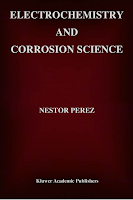
The interpretation of the above equations indicate that an anodic reaction, which is equivalent to what is known as oxidation, loses metal electrons and the cathodic reaction accepts or gains electrons for reducing pertinent ions. Consequently, both anodic and cathodic reactions are coupled in a corrosion process. Adding eqs. (1.1a) and (1.1b) yields eq. (1.1c). Thus, REDOX (RED = reduction and OX = oxidation) is the resultant reaction equation, eq. (1.1c), and represents the overall reaction at equilibrium where the anodic and cathodic reaction rates are equal.


